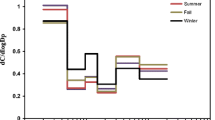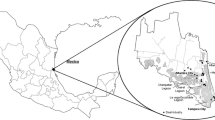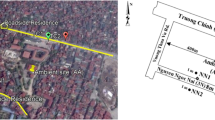Abstract
Principal component analysis (PCA) and correlation have been used to study the variability of particle mass and particle number concentrations (PNC) in a tropical semi-urban environment. PNC and mass concentration (diameter in the range of 0.25–>32.0 μm) have been measured from 1 February to 26 February 2013 using an in situ Grimm aerosol sampler. We found that the 24-h average total suspended particulates (TSP), particulate matter ≤10 μm (PM10), particulate matter ≤2.5 μm (PM2.5) and particulate matter ≤1 μm (PM1) were 14.37 ± 4.43, 14.11 ± 4.39, 12.53 ± 4.13 and 10.53 ± 3.98 μg m−3, respectively. PNC in the accumulation mode (<500 nm) was the most abundant (at about 99 %). Five principal components (PCs) resulted from the PCA analysis where PC1 (43.8 % variance) predominates with PNC in the fine and sub-microme tre range. PC2, PC3, PC4 and PC5 explain 16.5, 12.4, 6.0 and 5.6 % of the variance to address the coarse, coarser, accumulation and giant fraction of PNC, respectively. Our particle distribution results show good agreement with the moderate resolution imaging spectroradiometer (MODIS) distribution.








Similar content being viewed by others
References
Badarinath KVS, Madhavi Latha K, Kiran Chand TR, Gupta PK, Ghosh AB, Jain SL, Gera BS, Singh R, Sarkar AK, Singh N, Parmar RS, Koul S, Kohli R, Nath S, Ojha VK, Singh G (2004) Characterization of aerosols from biomass burning—a case study from Mizoram (Northeast), India. Chemosphere 54:167–175
Birmili W, Wiedensohler A, Heintzenberg J, Lehmann K (2001) Atmospheric particle number size distribution in central Europe: statistical relations to air masses and meteorology. J Geophys Res 106:32005–32018
Choi H, Choi DS (2008) Concentrations of PM10, PM2.5, and PM1 influenced by atmospheric circulation and atmospheric boundary layer in the Korean mountainous coast during a duststorm. Atmos Res 89:330–337
Chow JC, Watson JG, Lowenthal DH, Hackney R, Magliano K, Lehrman D, Smith T (1999) Temporal variations of PM2.5, PM10 and gaseous precursors during the 1995 integrated monitoring study in central California. J Air Waste Manage Assoc 49:16–24
Cusack M, Pérez N, Pey J, Alastuey A, Querol X (2013) Source apportionment of fine PM and sub-micron particle number concentrations at a regional background site in the western Mediterranean: a 2.5 year study. Atmos Chem Phys 13:5173–5187
Cyrys J, Pitz M, Heinrich J, Wichmann HE, Peters A (2008) Spatial and temporal variation of particle number concentration in Augsburg, Germany. Sci Total Environ 401:168–175
Draxler RR, Rolph GD (2013) HYSPLIT (HYbrid Single-Particle Lagrangian Integrated Trajectory) Model access via NOAA ARL READY Website (http://ready.arl.noaa.gov/HYSPLIT.php). NOAA Air Resources Laboratory, Silver Spring, MD
Durant JL, Ash CA, Wood EC, Herndon SC, Jayne JT, Knighton WB, Canagaratna MR, Trull JB, Brugge D, Zamore W, Kolb CE (2010) Short-term variation in near-highway air pollutant gradients on a winter morning. Atmos Chem Phys 10:5599–5626
Feng N, Christopher SA (2013) Satellite and surface-based remote sensing of Southeast Asian aerosols and their radiative effects. Atmos Res 122:544–554
Gabey AM, Gallagher MW, Whitehead J, Dorsey JR, Kaye PH, Stanley WR (2010) Measurements and comparison of primary biological aerosol above and below a tropical forest canopy using a dual channel fluorescence spectrometer. Atmos Chem Phys 10:4453–4466
Galindo N, Gil-Moltó J, Varea M, Chofre C, Yubero E (2013) Seasonal and interannual trends in PM levels and associated inorganic ions in southeastern Spain. Microchem J 110:81–88
Grimm H, Eatough DJ (2009) Aerosol measurement: the use of optical light scattering for the determination of particulate size distribution, and particulate mass, including the semi-volatile fraction. J Air Waste Manage Assoc 59:101–107
Harrison RM, Beddows DCS, Dall’Osto M (2011) PMF analysis of wide-range particle size spectra collected on a major highway. Environ Sci Technol 45:5522–5528
Harshvardhan (1993) Chapter 3 aerosol-climate interactions. V.H. Peter (Ed.) International Geophysics, Academic Press
Haywood J, Boucher O (2000) Estimates of the direct and indirect radiative forcing due to tropospheric aerosols: a review. Rev Geophys 38:513–543
Heintzenberg J (1994) Properties of the log-normal particle size distribution. Aerosol Sci Tech 21:46–48
Hinds WC (1999) Aerosol technology, properties, behavior, and measurement of airborne particles, 2nd edn. John Wiley & Sons, Inc., New York
Hu X, Zhang Y, Ding Z, Wang T, Lian H, Sun Y, Wu J (2012) Bioaccessibility and health risk of arsenic and heavy metals (Cd, Co, Cr, Cu, Ni, Pb, Zn and Mn) in TSP and PM2.5 in Nanjing, China. Atmos Environ 57:146–152
Jacobson MZ (2002) Control of fossil-fuel particulate black carbon and organic matter, possibly the most effective method of slowing global warming. J Geophys Res 107(D19):4410
Johansson C, Norman M, Gidhagen L (2007) Spatial & temporal variations of PM10 and particle number concentrations in urban air. Environ Monit Assess 127:477–487
Jung J, Kim YJ, Lee KY, Cayetano MG, Batmunkh T, Koo JH, Kim J (2010) Spectral optical properties of long-range transport Asian dust and pollution aerosols over Northeast Asia in 2007 and 2008. Atmos Chem Phys 10:5391–5408
Kampa M, Castanas E (2008) Human health effects of air pollution. Environ Pollut 151:362–367
Khan MF, Hirano K, Masunaga S (2010) Quantifying the sources of hazardous elements of suspended particulate matter aerosol collected in Yokohama, Japan. Atmos Environ 44:2646–2657
Kim H, Hwang H, Ro C-U (2006) Single-particle characterization of soil samples collected at various arid areas of China, using low-Z particle electron probe X-ray microanalysis. Spectrochim Acta B 61:393–399
Kittelson DB, Watts WF, Johnson JP (2004) Nanoparticle emissions on Minnesota highways. Atmos Environ 38:9–19
Kittelson DB, Watts WF, Johnson JP (2006) On-road and laboratory evaluation of combustion aerosols—part1: summary of diesel engine results. J Aerosol Sci 37:913–930
Leitte AM, Schlink U, Herbarth O, Wiedensohler A, Pan X-C, Hu M, Wehner B, Breitner S, Peters A, Wichmann HE, Franck U (2011) Associations between size-segregated particle number concentrations and respiratory mortality in Beijing, China. Int J Environ Health Res 22:119–133
Lonati G, Ozgen S, Ripamonti G, Cernuschi S, Giugliano M (2011) Pedestrian exposure to size-resolved particles in Milan. J Air Waste Manage Assoc 61:1273–1280
Meng X, Ma Y, Chen R, Zhou Z, Chen B, Kan H (2013) Size-fractionated particle number concentrations and daily mortality in a chinese city. Environ Health Perspect 121:1174–1178
Morales Betancourt R, Nenes A (2014) Understanding the contributions of aerosol properties and parameterization discrepancies to droplet number variability in a global climate model. Atmos Chem Phys 14:4809–4826
Nicolás JF, Yubero E, Pastor C, Crespo J, Carratalá A (2009) Influence of meteorological variability upon aerosol mass size distribution. Atmos Res 94:330–337
Pey J, Querol X, Alastuey A, Rodríguez S, Putaud JP, Van Dingenen R (2009) Source apportionment of urban fine and ultra-fine particle number concentration in a Western Mediterranean city. Atmos Environ 43:4407–4415
Pope CA, Burnett RT, Thurston GD, Thun MJ, Calle EE, Krewski D, Godleski JJ (2004) Cardiovascular mortality and long-term exposure to particulate air pollution: epidemiological evidence of general pathophysiological pathways of disease. Circulation 109:71–77
Pope CA, Dockery DW (2006) Health effects of fine particulate air pollution: lines that connect. J Air Waste Manage Assoc 56:709–742
Ramanathan V, Crutzen PJ, Kiehl JT, Rosenfeld D (2001) Aerosols, climate, and the hydrological cycle. Science 294:2119–2124
Reid JS, Hyer EJ, Johnson RS, Holben BN, Yokelson RJ, Zhang J, Campbell JR, Christopher SA, Di Girolamo L, Giglio L, Holz RE, Kearney C, Miettinen J, Reid EA, Turk FJ, Wang J, Xian P, Zhao G, Balasubramanian R, Chew BN, Janjai S, Lagrosas N, Lestari P, Lin N-H, Mahmud M, Nguyen AX, Norris B, Oanh NTK, Oo M, Salinas SV, Welton EJ, Liew SC (2013) Observing and understanding the Southeast Asian aerosol system by remote sensing: an initial review and analysis for the Seven Southeast Asian Studies (7SEAS) program. Atmos Res 122:403–468
Richards LW (1983) Comments on the oxidation of NO2 to nitrate—day and night. Atmos Environ 17:397–402
Řimnáčová D, Ždímal V, Schwarz J, Smolík J, Řimnáč M (2011) Atmospheric aerosols in suburb of Prague: the dynamics of particle size distributions. Atmos Res 101:539–552
Rimselyte I (2007) Chemical composition and size distribution of fine aerosol particles on the east coast of the Baltic Sea. Lith J Physic Tech Sci 47:523–529
Salam A, Mamoon HA, Ullah MB, Ullah SM (2012) Measurement of the atmospheric aerosol particle size distribution in a highly polluted mega-city in Southeast Asia (Dhaka-Bangladesh). Atmos Environ 59:338–343
Seinfeld J, Pandis SN (2006) Atmospheric chemistry and physics: from air pollution to climate change. Wiley, New York
Silva PJ, Liu D-Y, Noble CA, Prather KA (1999) Size and chemical characterization of individual particles resulting from biomass burning of local southern california species. Environ Sci Technol 33:3068–3076
Technik GA (2006) GRIMM Ambient Dust Monitor # 365 USER MANUAL. Grimm Aerosol Technik GmbH, Ainring Germany
Thurston GD, Spengler JD (1985) A quantitative assessment of source contributions to inhalable particulate matter pollution in metropolitan Boston. Atmos Environ 19:9–25
Tsai J-H, Tzu-Chi Chang L, Huang Y-S, Chiang H-L (2011) Particulate composition characteristics under different ambient air quality conditions. J Air Waste Manage Assoc 61:796–805
Van Malderen H, Rojas C, Van Grieken R (1992) Characterization of individual giant aerosol particles above the North Sea. Environ Sci Technol 26:750–756
Wan Mahiyuddin WR, Sahani M, Aripin R, Latif MT, Thach T-Q, Wong C-M (2013) Short-term effects of daily air pollution on mortality. Atmos Environ 65:69–79
Weber K, Vogel A, Fischer C, van Haren G, Pohl T (2010) Airborne measurements of the Eyjafjallajökull volcanic ash plume over northwestern Germany with a light aircraft and an optical particle counter: first results, Proc. SPIE 7832, Lidar technologies, techniques, and measurements for atmospheric remote sensing VI, pp. 78320P-78320P-15
Weinzierl B, Sauer D, Esselborn M, Petzold A, Veira A, Rose M, Mund S, Wirth M, Ansmann A, Tesche M, Gross S, Freudenthaler V (2011) Microphysical and optical properties of dust and tropical biomass burning aerosol layers in the Cape Verde region-an overview of the airborne in situ and lidar measurements during SAMUM-2. Tellus Ser B Chem Phys Meteorol 63:589–618
Whitby KT, Clark WE, Marple VA, Sverdrup GM, Sem GJ, Willeke K, Liu BYH, Pui DYH (1975) Characterization of California aerosols—I. Size distributions of freeway aerosol. Atmos Environ 9:463–482
Xian P, Reid JS, Atwood SA, Johnson RS, Hyer EJ, Westphal DL, Sessions W (2013) Smoke aerosol transport patterns over the Maritime Continent. Atmos Res 122:469–485
Xiaoai G, Grimm H, Pesch M, Keck L, Spielvogel J, Schneider F, Brunnhuber W (2010) New methods for real-time measurement of environmental airborne particles, bioinformatics and biomedical engineering (ICBBE), 4th International Conference, pp. 1-4
Xu J, Wang Z, Yu G, Sun W, Qin X, Ren J, Qin D (2013) Seasonal and diurnal variations in aerosol concentrations at a high-altitude site on the northern boundary of Qinghai-Xizang Plateau. Atmos Res 120–121:240–248
Yue D, Hu M, Wu Z, Wang Z, Guo S, Wehner B, Nowak A, Achtert P, Wiedensohler A, Jung J, Kim YJ, Liu S (2009) Characteristics of aerosol size distributions and new particle formation in the summer in Beijing. J Geophys Res 114:D00G12
Zhu Y, Hinds WC, Kim S, Sioutas C (2002) Concentration and size distribution of ultrafine particles near a major highway. J Air Waste Manage Assoc 52:1032–1042
Acknowledgments
The authors would like to thank the Universiti Kebangsaan Malaysia for the Research University Grant (DIP-2012-020). We also would like to thank the Ministry of Education for the Fundamental Research Grant (FRGS/1/2013/STWN01/UKM/02/2). Special thanks to Ms K Alexander and Dr. Rose Norman for proofreading this manuscript.
Author information
Authors and Affiliations
Corresponding author
Additional information
Responsible editor: Gerhard Lammel
Rights and permissions
About this article
Cite this article
Khan, M.F., Latif, M.T., Amil, N. et al. Characterization and source apportionment of particle number concentration at a semi-urban tropical environment. Environ Sci Pollut Res 22, 13111–13126 (2015). https://doi.org/10.1007/s11356-015-4541-4
Received:
Accepted:
Published:
Issue Date:
DOI: https://doi.org/10.1007/s11356-015-4541-4




